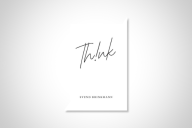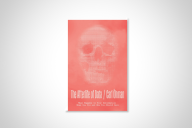You have /5 articles left.
Sign up for a free account or log in.
It is disagreeable to approach the cashier with a book called How to Read Hitler. One way to take the stink off would be to purchase one or two other volumes in the new How to Read series published by W. W. Norton, which also includes short guides to Shakespeare, Nietzsche, Freud, and Wittgenstein. But at the time, standing in line at a neighborhood bookstore a couple weeks ago, I wasn't aware of those other titles. (The only thing mitigating the embarrassment was knowing that my days as a skinhead, albeit a non-Nazi one, are long over.) And anyway, the appearance of Adolf Hitler in such distinguished literary and philosophical company raises more troubling questions than it resolves.
"Intent on letting the reader experience the pleasures and intellectual stimulation in reading classic authors," according to the back cover, "the How to Read series will facilitate and enrich your understanding of texts vital to the canon." The series editor is Simon Critchley, a professor of philosophy at the New School in New York City, who looms ever larger as the guy capable of defending poststructuralist thought from its naysayers. Furthermore, he's sharp and lucid about it, in ways that might just persuade those naysayers to read Derrida before denouncing him. (Yeah, that'll happen.)
Somehow it is not that difficult to imagine members of the National Association of Scholars waving around the How to Read paperbacks during Congressional hearings, wildly indignant at Critchley's implicit equation of Shakespeare and Hitler as "classic authors" who are "vital to the canon."
False alarm! Sure, the appearance of the Fuhrer alongside the Bard is a bit of a provocation. But Neil Gregor, the author of How to Read Hitler, is a professor of modern German history at the University of Southampton, and under no illusions about the Fuhrer's originality as a thinker or competence as a writer.
About Mein Kampf, Gregor notes that there is "an unmistakably 'stream of consciousness' quality to the writing, which does not appear to have undergone even the most basic editing, let alone anything like polishing." Although Gregor does not mention it, the title Hitler originally gave to the book reveals his weakness for the turgid and the pompous: Four and a Half Years of Struggle against Lies, Stupidity and Cowardice. (The much snappier My Struggle was his publisher's suggestion.)
Incompetent writers make history, too. And learning to read them is not that easy. The fact that Hitler had ideas, rather than just obsessions, is disobliging to consider. Many of the themes and images in his writing reflect an immersion in the fringe literature of his day -- the large body of ephemeral material analyzed in Fritz Stern in his classic study The Politics of Cultural Despair: The Rise of the Germanic Ideology.
But Gregor for the most part ignores this influence on Hitler. He emphasizes, instead, the elements of Hitler's thinking that were, in their day, utterly mainstream. He could quote whole paragraphs Carl de Clausewitz on strategy. And his racist world view drew out the most virulent consequences of the theories of Arthur de Gobineau and Houston Stewart Chamberlain.(While Hitler was dictating his memoirs in a prison following the Beer Hall Putsch, he could point with admiration to one effort to translate their doctrines into policy: The immigration restrictions imposed in the United States in the 1920s.)
Gregor's method is to select passages from Mein Kampf and from an untitled sequel, published posthumously as Hitler's Second Book. He then carefully unpacks them -- showing what else is going on within the text, beneath the level of readily paraphrasable content. With his political autobiography, Hitler was not just recycling the standard complaints of the extreme right, or indulging in Wagnerian arias of soapbox oratory. He was also competing with exponents of similar nationalist ideas. He wrote in order to establish himself as the (literally) commanding figure in the movement.
So there is an implicit dialogue going on, disguised as a rather bombastic monologue. "Long passages of Hitler's writings," as Gregor puts it, "take the form of an extended critique of the political decisions of the late nineteenth century.... Hitler reveals himself not only as a nationalist politician and racist thinker, but -- this is a central characteristic of fascist ideology -- as offering a vision of revitalization and rebirth following the perceived decay of the liberal era, whose failings he intends to overcome."
The means of that "overcoming" were, of course, murderous in practice. The vicious and nauseating imagery accompanying any mention of the Jews -- the obsessive way Hitler constantly returns to metaphors of disease, decay, and infestation -- is the first stage of a dehumanization that is itself an incipient act of terror. The genocidal implications of such language are clear enough. But Gregor is careful to distinguish between the racist stratum of Hitler's dogma (which was uncommonly virulent even compared to the "normal" anti-Semitism of his day) and the very widespread use of militarized imagery and rhetoric in German culture following World War I.
"Many of the anti-Semitic images in Hitler's writing can be found in, say, the work of Houston Stewart Chamberlain," writes Gregor. "Yet when reading Chamberlain's work we hardly sense that we are dealing with an advocate of murder. When reading Hitler, by contrast, we often do -- even before we have considered the detail of what he is discussing. This is because the message is not only to be found in the arguments of the text, but is embedded in the language itself."
How to Read Hitler is a compact book, and a work of "high popularization" rather than a monograph. The two short pages of recommended readings at the end are broad, pointing to works of general interest (for example, The Coming of the Third Reich by Richard Evans) rather than journal articles. It will find its way soon enough into high-school and undergraduate history classrooms -- not to mention the demimonde of "buffs" whose fascination with the Third Reich has kept the History Channel profitable over the years.
At the same time, Gregor's little book is an understated, but very effective, advertisement for the "cultural turn" in historical scholarship. It is an example, that is, of one way historians go about examining not just what documents tell us about the past, but how the language and assumptions of a text operated at the time. His presentation of this approach avoids grand displays of methodological intent. Instead the book just goes about its business -- very judiciously, I think.
But there is one omission that is bothersome. Perhaps it is just an oversight, or, more likely, a side effect of the barriers between disciplines. Either way, it is a great disservice that How to Read Hitler nowhere points out the original effort by someone writing in English to analyze the language and inner logic of Mein Kampf -- the essay by Kenneth Burke called "The Rhetoric of Hitler's 'Battle,' " published in The Southern Review in 1939. (In keeping with my recent enthusing over the "golden age" of the academic literary quarterly, it is worth noting that the Review was published at Louisiana State University and edited by a professor there named Robert Penn Warren.)
Burke's essay was, at the time, an unusual experiment: An analysis of a political text using the tools of literary analysis that Burke had developed while studying Shakespeare and Coleridge. He had published the first translations of Thomas Mann's Death in Venice and of portions of Oswald Spengler's Decline of the West -- arguably a uniquely suitable preparation for the job of reading Hitler. And just as various German émigrés had tried to combine Marx and Freud in an effort to grasp "the mass psychology of fascism" (as Wilhelm Reich's title had it), so had Burke worked out his own combination of the two in a series of strange and brilliant writings published throughout the Depression.
But he kept all of that theoretical apparatus offstage, for the most part, in his long review-essay on a then-new translation of Mein Kampf. Instead, Burke read Hitler's narrative and imagery very closely -- showing how an "exasperating, even nauseating" book served to incite and inspire a mass movement.
This wasn't an abstract exercise. "Let us try," wrote Burke, "to discover what kind of 'medicine' this medicine man has concocted, that we may know, with greater accuracy, exactly what to guard against, if we are to forestall the concocting of similar medicine in America."
Burke's analysis is a [ital]tour de force[ital]. Revisiting it now, after Gregor's How to Read volume, it is striking how much they overlap in method and implication. In 1941, Burke reprinted it in his collection The Philosophy of Literary Form, which is now available from the University of California Press. You can also find it in a very useful anthology of Burke's writings called On Symbols and Society, which appears in the University of Chicago Press's series called "The Heritage of Sociology."
"Above all," wrote Burke in 1939, "I believe we must make it apparent that Hitler appeals by relying upon a bastardization of fundamentally religious patterns of thought. In this, if properly presented, there is no slight to religion. There is nothing in religion proper that requires a fascist state. There is much in religion, when misused, that does lead to a fascist state. There is a Latin proverb, Corruptio optimi pessima, 'the corruption of the best is the worst.' And it is the corruptors of religion who are a major menace to the world today, in giving the profound patterns of religious thought a crude and sinister distortion."








